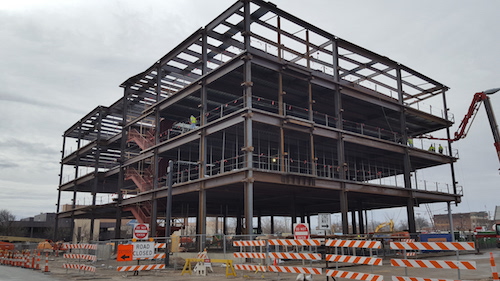Construction is on an upswing in
Evansville, Ind., a city of about 120,000 people nestled in a bend in the Ohio
River.

|
| Detroit Local 58 members are among the workers on the $728 million Little Caesars Arena. The new home for the NHL’s Red Wings and NBA’s Pistons is scheduled to open in September.
|
Evansville Local 16 members worked on a downtown hotel that was recently finished. They’re now working on a new casino, new elementary school and a new Indiana University Medical School research center.. Two local hospitals are involved in large-scale projects.
It’s all led to near full employment for its 970 members, Business Manager Paul Green said.
“There’s been some pretty positive trends here,” he said.
The situation in Evansville isn’t unique. Construction is booming across the country, leading to more work for IBEW members. But this new growth brings with it challenges the IBEW must meet if it wants to continue growing and seize the opportunity to build market share.
The hot construction market has revealed a growing skilled worker shortage, which is being felt across the industry. For the IBEW, that makes organizing the top priority.
“It’s hugely important,” Construction and Maintenance Director Jim Ross said. “If we can’t supply the workers, our signatory contractors won’t bid on projects.”
Nationally, Dodge Data and Analytics estimated new construction starts to increase 5 percent nationally this year over 2016.. Job growth showed no sign of slowing down nationally as 2017 dawned. An estimated 36,000 construction jobs were added in January.
For members enjoying steady work, that’s great news.
But the IBEW’s Membership Development Department reports that 42 locals across the country were experiencing open calls and 15 are expected to have a worker shortage of 100 or more during the next six months.
That may just be scratching the surface. Phoenix Local 640 expects to be between 400 and 800 workers short later this year as construction rebounds in the Valley of the Sun. Beaver, Pa., Local 712 already is 400 workers short and projects to need 2,000 additional workers for work on refinery and plastics plants in the area.
If the IBEW doesn’t meet the demand quickly, its market share – which has held at 30 percent nationally since 2011 – could decrease, sending the work elsewhere and lessening its bargaining power on projects.
“There just isn’t a magic bullet,” Director of Construction Organizing Virgil Hamilton said. “What we’re trying to do is get the locals to put in place programs that not only will fill our immediate needs, but will lead to where they don’t have to continue to look for short-term fixes.”
Part of meeting the shortage is targeting the approximately 464,000 nonunion electrical workers in the United States.
Membership naturally contracts during a construction downturn. In the past, the IBEW hasn’t responded quickly enough to reverse that when the economy improves, Business Development Director Ray Kasmark said. That’s caused uncertainty for signatory contractors and others it is trying to do business with.
“The next five years are going to be crucial,” Kasmark said. “There’s a lot of pent-up demand in construction that’s going to explode. Who are going to be the players to do that work? The door is wide open.”
Added Hamilton: “If our contractors pass on the work, the nonunion contractors grow, not us. If the market grows, we need to grow with it.”

|
| Work on Indiana University Medical School’s hospital and research center is expected to be completed in early 2018. Evansville, Ind., Local 16 is supplying workers for the project. Photo courtesy of Indiana University School of Medicine-Evansville.
|
Recession, Retirements Hit Hard
For the IBEW, membership fell following the 2008 economic collapse, leading some locals to take on fewer apprentices in the following years because of the decreased demand.
Green, for instance, said Local 16 halved its program. Detroit Local 58 Business Manager Michael Richard said its training center cut back to 200 apprentices at one point, well below its capacity of 725, which it is expected to soon return to.
Around the same time, the baby boomer generation, which makes up a large percentage of membership, began to retire. More than 100,000 members could retire in the next 10 years.
“We are trying to change the organizing culture,” said Ricky Oakland, assistant to the president for Membership Development. “In the past, we have liked this situation where we have more jobs than workers. That equals more security.”
But that leads to trouble if it isn’t accompanied by successful organizing, he said.
“Owners are moving back deadlines and we lose those jobs,” Oakland said. “As the pie grows, we want to increase our percentage of the pie.”
Focusing on Local Organizing
The Membership Development Department has a new program that assigns organizing staff to an individual local on a full-time basis if requested by the business manager. Potential market growth is one factor considered, but it also is available to business managers looking for new ways to add members.
The program helped Modesto, Calif., Local 684 increase its membership by nearly 70 percent last year. Business Manager Billy Powell said he was looking for ways to grow membership after it fell to nearly 200 members following the economic collapse. It is now up to about 350.
The program now is being used at Sacramento, Calif., Local 340 and Orlando Local 606, amid estimates that area will see upwards of $18 billion in new construction spending in the upcoming year.
The intensive localized organizing efforts include advertising on social media platforms and alerting nonunion electricians to immediate opportunities as members of the IBEW.
“You plant those seeds and build those relationships,” Hamilton said. “There will come a day when those workers will get upset with their nonunion employer and they come to us.”
There will be some old-fashioned methods, too. Hamilton said part of his message to business managers is involving all members in organizing. It can be as simple as someone taking a picture of a nonunion jobsite while driving through their communities and sending it to their local’s organizers.
That’s just what Phoenix Local 640 Business Manager Dean Wine is doing.
Arizona has been a right-to-work state for 70 years and long has been regarded as one of the most unfriendly to labor. Project labor agreements – which establish pay rates and working conditions on projects before contracts are awarded – are virtually nonexistent.
Construction has rebounded in the area, however, so Local 640 organizers plan to spend time outside nonunion jobsites telling workers about the benefits of IBEW membership.
“When you can tell them you have a job waiting for them, they’re more likely to make a move,” Wine said.
Recruiting the Workers
Detroit has a deeper union history, but is expecting a worker shortage because of a variety of projects, the most notable being the new arena for the NHL’s Red Wings and NBA’s Pistons. Richard said Local 58 will have a job fair to attract new members in mid-May and is adding to its organizing staff to reach out to more nonunion electricians.
“We’re not going to apprentice our way out of this,” Richard said. “We can’t. We’re going to need to get back to our roots and that’s organizing and taking the underrepresented into our brotherhood.”
Hand-in-hand with organizing are alternate job classifications, which allow workers who have not joined an apprenticeship program but are doing electrical work to join. They help lower costs for signatory contractors and allow them to successfully bid on more projects in competitive markets that increasingly have nonunion options, and make it easier for the IBEW to organize.
“The industry is changing and we have to look at new ways to attract business,” Ross said.
Wine said the alternative job classifications are a necessity for Local 640.
“If we organized all 12,000 electricians in [metropolitan Phoenix], a small percentage of them would qualify as journeymen,” he said. “You can’t put them all in apprenticeships. You go place them with their skill level.”
Organizing Workers – And the Work

|
| Construction starts are projected to increase 5 percent in 2017, according to one leading research firm. The IBEW plans to use that to expand its share of the market.
|
Also vital to the IBEW’s growth are efforts by the Business Development Department to proactively go after new jobs while many of these projects are still in the planning stage.
With the help of research at the International office, the 12 business development representatives spread out across the U.S. identify areas that are primed for job growth and show business managers ways to take advantage of them.
A recent success story came at Albany, Ga., Local 1531 after energy company Exelon announced it would build a biomass plant there.
The IBEW and its signatory contractors had worked with the company on projects in the Northeast. They used those connections to help secure work on the project for Local 1531, which had only 49 members before it bid on the contract, Business Manager Allan York said. That number is up to 78 and is expected to rise to more than 100.
Most travelers in Georgia are working on a nearby nuclear plant, so the IBEW has met the demand by organizing nonunion electricians, Kasmark said.
“It was absolutely a team effort,” said York, adding that Fifth District Vice President Joseph Davis and business representative Bill Dever were particularly helpful.
Kasmark said it’s a good example of a collaborative effort that can increase membership numbers.
“Our signatory contractors need more security,” he said. “If we can provide the members, they’ll feel like they have less risk to bid on a project because they’ll have the available manpower.”
Overall, the construction rebound has led to cautious optimism.
“I think there are some positive trends ongoing,” Sixth District Vice President David J. Ruhmkorff said. “I think we can capitalize on it if our locals are willing to go after it and are prepared -- and I think they are.”